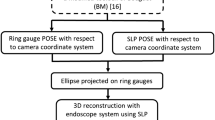Abstract
Automated optical mensuration gauges the acquired image of the inspected unit while assessing its actual size and shape. The mensuration requires the following preparations: (1) alignment of the video camera perpendicularly to the inspection table, and (2) calibration of the scale ratios of image acquisition, notably, the stretching ratio caused by signal conversion and the magnification ratio of optical coupling. This paper presents the unique two-stage calibration method. The first stage applies the parallelogram conservation property, a property very sensitive to misorientation, to test against the potential misalignment. Once detected, we adjust the misalignment towards orthogonal alignment using image patterns of the calibration template. Then, the second stage determines the scale ratios. The proposed calibration method is suitable for on-site applications, and its implementation cost is low. Sensitivity analysis and experimental results are reported.
Similar content being viewed by others
References
Abdel-Aziz YI, Karara HM (1971) Direct linear transformation into object space coordinates in close-range photogrammetry. Symposium on Close-Range Photogrammetry, pp 1–18
Abdel-Aziz YI, Karara HM (1974) Photogrammetric potential of non-metric cameras. Civil Engr Studies, Photogrammetry Series No. 36, Univ. of Illinois at Urbana-Champaign
Brown DC (1971) Close range camera calibration. Photogrammetric Eng 37:855–866
Chen HH (1991) Pose determination from line-to-plane correspondences:existence condition and closed-form solutions. IEEE Trans Pattern Anal Machine Intell 13:530–541
Chen W, Jiang BC (1991) 3-D camera calibration using vanishing point concept. Pattern Recog 24:57–67
Chin RT (1988) Survey-automated visual inspection: 1981 to 1987. Comput Vision Graph Image Process 41:346–381
Faig W (1975) Calibration of close-range photogrammetry systems: mathematical formulation. Photogrammetric Eng Remote Sensing 41:1479–1486
Graybill FA (1976) Theory and application of the linear model. Duxbury Press, North Scituate, Mass
Han MH, Rhee S (1992) Camera calibration for three-dimensional measurement. Pattern Recogn 25:155–164
Haralick RM, Shapiro LG (1993) Computer and robot vision, Volumes I & II, Addison-Wesley, Reading, Mass
Hect M, Zajac A (1987), Optics. 2nd edn, Addison-Wesley, Reading, Mass
Karara HM (1979) Handbook of non-topographic photogrammetry. (American Society of Photogrammetry) Falls Church, VA
Light DL (1992) The new camera calibration system at the U.S. geological survey. Photogrammetric Eng Remote Sensing 58:185–188
Malhotra VM (1971) A computer program for the calibration of close-range cameras. Proceedings of Symposium on Close Range Photogrammetric Systems, pp 62–80
Nomura Y, Sagara M, Naruse H, Ide A (1992) Simple calibration algorithm for high-distortion-lens camera. IEEE Trans Pattern Anal Machine Intell 14:1095–1099
Okamoto A (1981) Orientation and construction of models, part I:the orientation problem in close-range photogrammetry. Photogrammetric Eng Remote Sensing 47: 1437–1454
Okamoto A (1984) The model construction problem using the collinearity condition. Photogrammetric Eng and Remote 50:705–711
Otsu N (1979) A threshold selection method from gray-level histograms. IEEE Trans Sys Man Cybernetics SMC-9:62–66
Pehkonen K, Harwood D, Davis LS (1991) Parallel calculation of 3-D pose of a known object in a single view. Pattern Recogn Letters 12:353–361
Penna MA (1991a) Determining camera parameters from the perspective projection of a quadrilateral. Pattern Recogn 24:533–541
Penna MA (1991b) Camera calibration: a quick and easy way to determine the scale factor. IEEE Trans Pattern Anal Machine Intell 13:1240–1245
PULNiX America (1989) PULNiX TM-540/560 CCD camera specifications, Sunnyvale, Ca/if
Sobel I (1974) On calibrating computer controlled cameras for perceiving 3-D scenes. Artif Intell 5: 185–198
Tsai RY (1987) A versatile camera calibration technique for high-accuracy 3D machine vision metrology using off-the-shelf TV cameras and lenses. IEEE Trans Robotics Automation, RA-3:323–344
Tsai RY, Lenz RK (1987), Techniques for calibration of the scale factor and image center for high accuracy 3D machine vision metrology. Proceedings IEEE International Conference Robotics and Automation, pp 68–75
Wang CC (1992) Extrinsic calibration of a vision sensor mounted on a robot. IEEE Trans Robotics Automation RA-8:161–175
Wang CC, Lai KC (1990) Solving the cubic monocular pose problem by the vanishing point method. The First International Conference on Automation Technology, pp 215–224
Wang LL, Tsai WH (1991) Camera calibration by vanishing lines for 3-D computer vision. IEEE Trans Pattern Anal Machine Intell 13:370–376
Wong KW (1975) Mathematical formulation and digital dnalysis in close-range photogrammetry. Photogrammetric Eng Remote Sensing 41:453–461
Zuech M (1988) Applying Machine Vision John Wiley & Sons, New York, p 95
Author information
Authors and Affiliations
Corresponding author
Rights and permissions
About this article
Cite this article
Wang, CC. A low-cost calibration method for automated optical mensuration using a video camera. Machine Vis. Apps. 7, 259–266 (1994). https://doi.org/10.1007/BF01213416
Issue Date:
DOI: https://doi.org/10.1007/BF01213416




